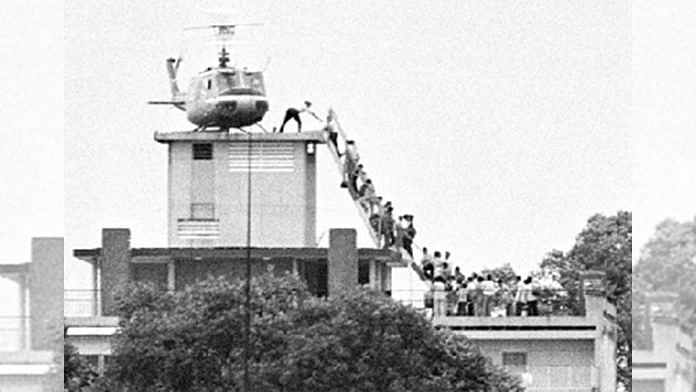New Delhi: The Joe Biden-led US administration deployed 3,000 fresh troops to Kabul airport for a partial evacuation of the US Embassy Friday, as the Taliban continues to capture large territories in Afghanistan — most recently Kandahar, the country’s second biggest city.
US lawmakers, including Republican Senator Mitch McConnell, have compared US’ present retreat from Afghanistan to the “humiliating” withdrawal from Saigon in 1975 at the end of the Vietnam War.
“The latest news of a further drawdown at our Embassy and a hasty deployment of military forces seem like preparations for the fall of Kabul,” McConnell said.
Meanwhile, House Representative Mike Rogers, who belongs to the Republican Party and is also a member of the House Armed Services Committee, termed the current developments “President Biden’s Saigon moment” in a statement Thursday.
Rogers was referring to the evacuation of American diplomatic staff and Vietnamese people via helicopters from the rooftop of the US embassy in Saigon on 29 April 1975.
This is a comparison that has been made in the past as well. Last month, when asked by reporters if a situation similar to Saigon will unfold in Afghanistan, Biden had said: “None whatsoever. Zero.” He added there would be no circumstance in which “you’re going to see people being lifted off the roof of a embassy”.
ThePrint explains what the fall of Saigon during the Vietnam War entailed.
Also read: Don’t forget us as we fight Taliban, says Afghan leader who thwarted Indian mission attack
Vietnam War handled under two US presidencies
The Vietnam War, which took place from 1955 to 1975, was fought between the Communist government in North Vietnam and South Vietnam with its principal ally, the US.
The US, under President Lyndon B. Johnson, entered the war in 1965. This was after he approved a national security agency memorandum in November 1963 that allowed the US “to assist the people and Government of South Vietnam to win their contest against the externally directed and supported Communist conspiracy”, notes Miller Center, an affiliate of the University of Virginia.
Within three years, the US had over 5 lakh troops posted in Vietnam.
Later, President Richard Nixon assumed responsibility for the war after being elected to office in 1969.
Fall of Saigon
In January 1973, the US and North Vietnam reached a ceasefire agreement, known as the Paris Peace Accords, and the US began withdrawing troops.
However, by 1974, North Vietnam had violated the agreement and renewed their assault on the South. Although most of the US military had left by then, approximately 5,000 Americans remained in the country, including diplomats still working in the US embassy in Saigon, according to the US State Department website.
The North Vietnamese Army captured more and more southern cities between March and April 1975, causing South Vietnamese to flee in mass numbers.
The end of the war was marked by the capture of Saigon on 30 April 1975 by the North Vietnamese Army.
Also read: Afghanistan urges world to act against Taliban ‘war crimes’, says ‘global security’ at stake
Operation Frequent Wind
Between 29 and 30 April 1975, American helicopters landed at 10-minute intervals on the rooftop of the US embassy in Saigon to evacuate American diplomatic staff and at-risk Vietnamese.
Called Operation Frequent Wind, over 7,000 people were evacuated, including 5,500 Vietnamese, in less than 24 hours. It was by far the most ambitious helicopter airlift in history, which also depicted a desperate US withdrawal from Vietnam.
One of the most iconic photographs of the war, clicked by Dutch photojournalist Hugh Van Es, showed a group of people desperately scaling a ladder to a CIA helicopter on the rooftop of the embassy.
(Edited by Rachel John)
Also read: When Bush, top US officials compared Afghan War to Vietnam War — a war America lost



